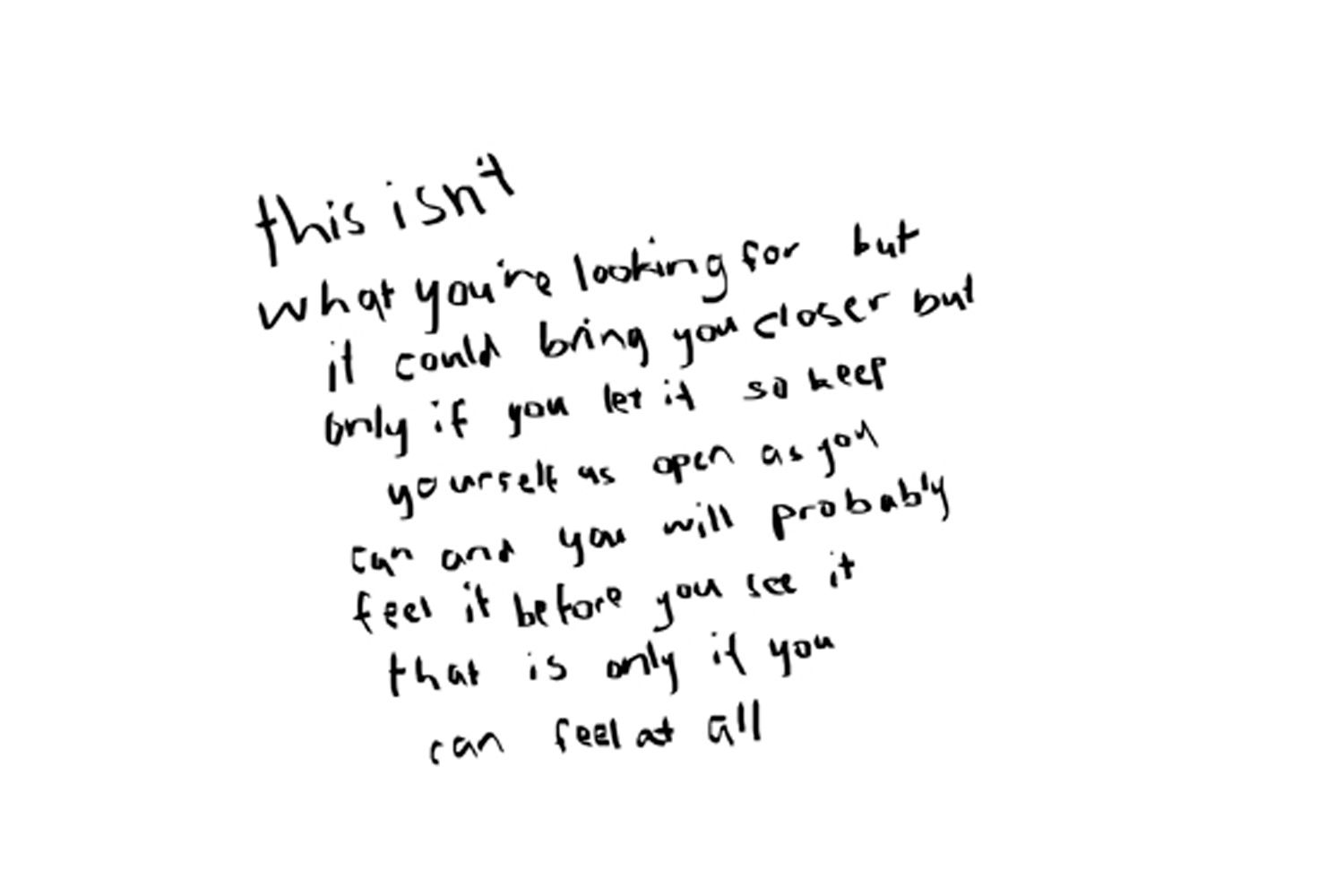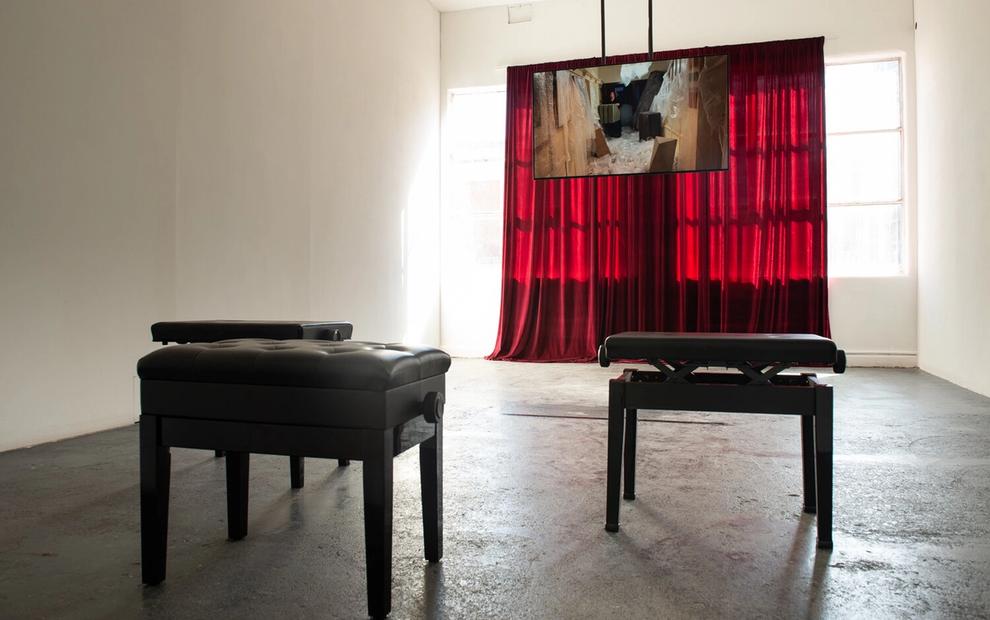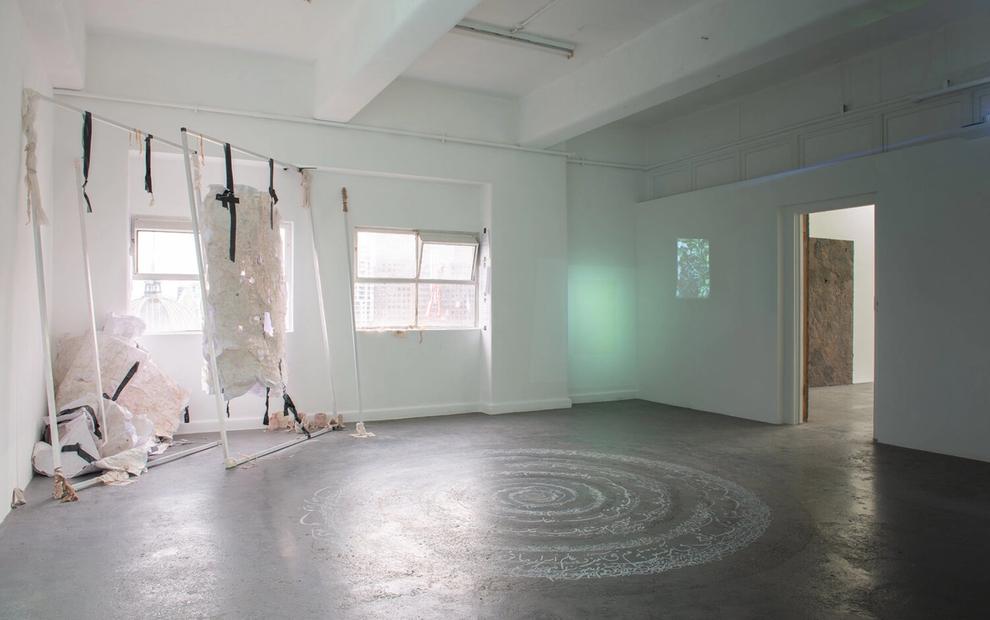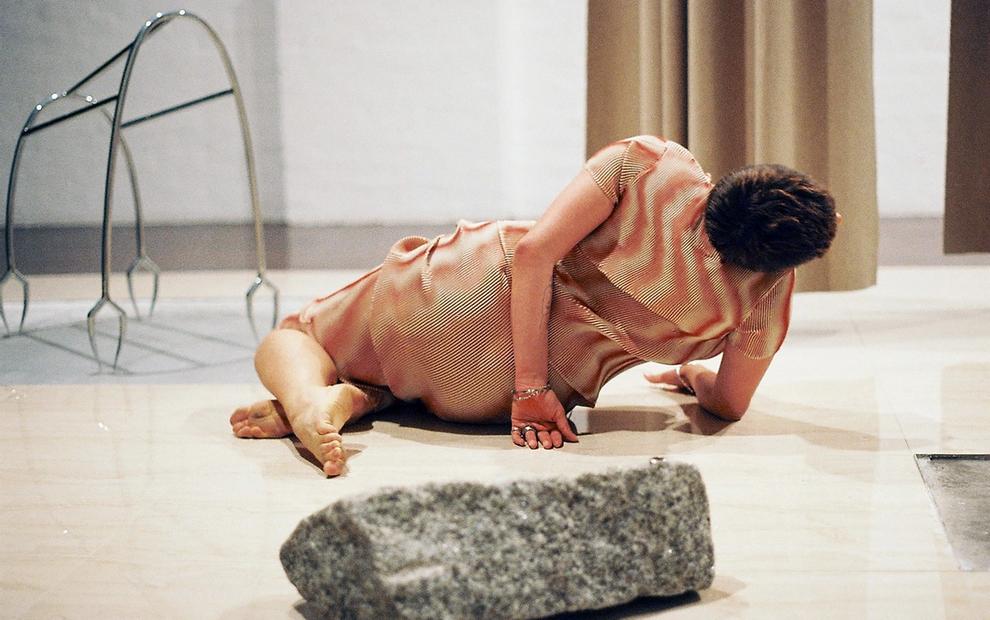

Debut XIV: Like Mist I am Neither the Sea, Nor the Sky
Madeleine Thornton-Smith, Josephine Mead, Tori Lill, Daniel Stephensen
14 Feb–3 Mar 2018
In its fourteenth year, DEBUT XIV profiled exciting new work by selected recent graduates from Melbourne's leading art institutes - RMIT, VCA + Monash University.
Blindside was thrilled to present the work of Josephine Mead, Tori Lill and Madeleine Thornton-Smith. Albeit distinctly unique, the work of each artist is profoundly contemplative and bound by an exploration of the liminal or the in-between.
Liminality describes a space of hovering and a type of ambiguity. It is a threshold between two defined areas - between death and burial, between the end of day and the beginning of night. Liminality is an airport or a hotel. It is that airborne moment in which we find ourselves, after leaping from a rock but before the water swallows us up whole.
In like mist, I am neither the sea nor the sky, memory, human gesture and seductive imagery meet, simultaneously evoking doubt and hope. The works presented as part of this exhibition explored notions of time and ending, disparate states of being and consciousness, as well as the differences and similarities between mediums.
- Lucie McIntosh
Tori Lill is a Melbourne-based artist working in the realm of photography, video and installation. In 2017, Tori completed her BFA (Honours) from the Victorian College of the Arts. Her work broadly explores notions of the in-between both physically and psychologically through distancing, (lack of) touch and removal of the self. Through interrogating the relationship of image and self, and image and viewer - Tori seeks to scrutinise the act of contemplation and embodied experience.
Contemporary author Sean Cubitt explains, that in the world of the pixel, ‘space is neither a pre-measured geometric grid nor a geometric projection from a vanishing point, but a construction of the projection of each entity and the relations between them, and that these projections of entities and their relations are space. Space, in other words, is not a void waiting to be filled but the product of relationships.’ Space is the distance between two things. The works presented for this exhibition use text and image in both digital and analogue forums to interrogate space and our preconceived notions of it.
In 2014 Josephine Mead completed a Bachelor Degree in Fine Art at RMIT. In 2017 Josephine completed Honours in Fine Art at Monash University. Working through photography, sculpture, installation, writing and video, Josephine is interested in assessing the ways in which she is capable of giving and receiving support.
The work presented for this exhibition act as a bridge between autonomous self-examination and an ongoing document of Josephine's relationship with her 91-year-old grandmother who has advanced Alzheimers. Through photographic and sculptural means the artist seeks to examine the ways we are in and out of time with one another. Memory-loss is a productive force that consistently pushes one out of time. Josephine is pushing back against this force, resisting losing time and space with her grandmother. By exchanging notions of futility for futurity, these works seek moments of connection, self-realisation and care.
The photographs move through different temporal registers; turning photographic time into a performative function and questioning the artists standing and sense of self. The wooden support-structure considers how the artist is capable of support. Scholar Peggy Phelan states that ‘tragic theatre embodies the... force of existence-as-rehearsal.’ Through this work, the artist is rehearsing for roles that she is yet to understand.
Madeleine Thornton–Smith has a background in painting and training in ceramics. Having moved from a primarily image-based practice to an object-based practice, Madeleine is interested in the tension between these two forms of artmaking. In 2017 she achieved First-Class Honours in Object-Based Practice (Ceramics) at RMIT. Recently she has been challenging traditional archetypes of the vessel, pedestal and canvas by subverting the idea of the “support” or “medium” in contemporary art. Exploring Marshall McLuhan’s claim that “the ‘content’ of any medium is always another medium” (in Lange-Berndt, 2015, p. 200), she asks whether the “content” of an object changes if its medium challenges an expected archetype.
The works presented for this exhibition question where distinct “mediums” end and others begin. Remediation is the act of re-forming an object in a material from which it wouldn’t usually be made. This notion been integral to explorations into the medium and the support.
Amy Gogarty argues that the process of remediation leads to new realities; mediums borrow, repurpose or refashion examples from within their own history, as a form of homage or critique, or as a formal rhetorical device to reinterpret older media (2007, p. 95).
Plinths, shelves and frames are so often invisible “furniture” in the gallery; objects which traditionally obfuscate themselves, to disappear, beneath that which is more “important”, the “art”. Reconfiguring these forms has included experimenting with not only with traditional clay and glazes but with making canvases, vessels and plinths out of related materials such as plaster, canvas, paper clay, concrete, papier mâché and paint. For example, Madeleine has slip-cast paintings into ceramic and created frames out of acrylic paint, using it as sculptural material in its own right. Her works mimic each other in texture and form, existing in a back-and- forth dialogue; one process leading to the other, and back again, challenging the viewer’s perception of the material’s content.






In its fourteenth year, DEBUT XIV profiled exciting new work by selected recent graduates from Melbourne's leading art institutes: Josephine Mead, Tori Lill + Madeleine Thornton-Smith. Albeit distinctly unique, the work of each artist is profoundly contemplative and bound by an exploration of the liminal or the in-between.
This program takes place on the land of the Wurundjeri people of the Kulin Nation. We recognise that sovereignty was never ceded - this land is stolen land. We pay respects to Wurundjeri Elders, past, present and emerging, to the Elders from other communities and to any other Aboriginal or Torres Strait Islanders who might encounter or participate in the program.
Madeleine Thornton-Smith has obtained various qualifications including a Bachelor of Arts/Visual Arts (Monash, 2013), Honours of Fine Art (Monash, 2014) and Diploma of Ceramics (Holmesglen, 2017). In 2017 she achieved First-Class Honours in Object-Based Practice (Ceramics) at RMIT. Madeleine has exhibited in various galleries throughout Melbourne, including Monash University, Topshelf gallery, Seventh, Lamington Drive and Craft Victoria.
Josephine Mead is a visual artist, curator & writer, residing on Wurundjeri woi-wurrung Country. She works through photography, sculpture, installation and writing to explore personal notions of support. Her recent work has positioned female family members as support-structures, considered the body as a site of discursive practice, explored notions of deep listening; examined the temporal and sonic nature of writing and photography; and charted notions and experiences of queer-love.
She has exhibited in many solo and group exhibitions, in Australia and abroad. She has undertaken residency programs in rural Victoria (The Macfarlane Fund), Mexico (Arquetopia Foundation), Portugal (Córtex Frontal), Turkey (Tasarim Bakkali TAB) and Germany (ZK/U). She was an inaugural Room to Create studio artist at Collingwood Yards. She co-founded Co- Publishing (with Christine McFetridge) in 2020 and was a founding Artistic Director of MILK Gallery in 2022. In 2023 she participated in the Writing in the Expanded Field program through the Australian Centre for Contemporary Art (ACCA). She was Chair of Artistic Directors for Blindside Gallery from 2020-2022 and re-joined the Blindside team as Community Coordinator in 2024.
Tori Lill is a Melbourne-based artist working in the realm of photography, video and installation. In 2017, Tori completed her BFA (Honours) from the Victorian College of the Arts. Her work broadly explores notions of the in-between both physically and psychologically through distancing, (lack of) touch and removal of the self. Through interrogating the relationship of image and self, and image and viewer - Tori seeks to scrutinise the act of contemplation and embodied experience. Tori has previously shown at Blindside as part of the PLAY Program and in 2016 was the recipient of the Bus Projects Award and the NGV Womens Association Award at the VCA Graduate Exhibition.
Lucie McIntosh is an artist, curator and writer with a deep commitment to the independent arts community. She is currently a Director and Program Curator of Blindside, an independent, artist–run space based in the City of Melbourne. Lucie’s exhibition and research based practice explores process of signification and, more specifically, in how the process of signification might be made visible through the content of an artwork. Her practice emphasises the inherently plural and personal nature of meaning—reminding us of, and celebrating, our agency in its creation. Lucie is interested in the many ways that ‘the image’ can be expanded and consumed in political and philosophical contexts. Her practice relies on plurality and intertextuality—each artwork compulsively referencing its many varieties of self, content, history and maker.
Related

4–20 Feb 2021
Debut XVII : Made to Keep the Memory Alive
Ponch Hawkes, Nina Sanadze, Kurt Medenbach, Levi Franco

6–22 Feb 2020
Debut XVI: To Love it All Again
Farnaz Dadfar, David Green, Edwina Green, Daniel R Marks, Juan Rodriguez Sandoval, Tina Stefanou, Sarah Ujmaia, Stephanie Symington

14 Feb–2 Mar 2019
Debut XV
Lauren Gostin, Andre Franco, Erin Hallyburton, Grace Carver, IchikawaEdward, Paris Fontana, Yvette James



